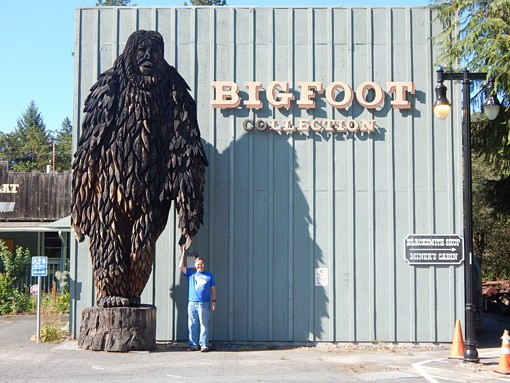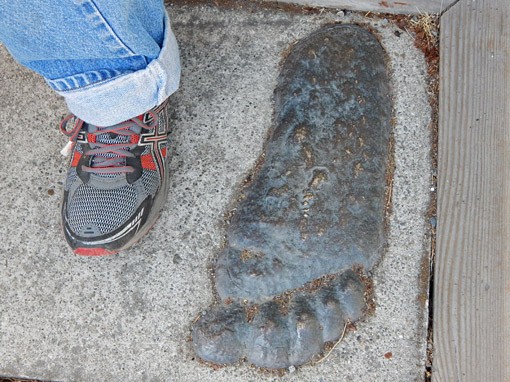Order the hardcover from Shop Skeptic
Order the hardcover from Amazon
Order the Kindle Edition
Order the Apple iBook
Last month I was doing geologic field work in northern California, and I had the opportunity to travel across the Klamath Mountains. Naturally, I saw many of the signs of Bigfoot Country. There’s a tacky “museum” and store down in Garberville near the Humboldt Redwoods, right off Highway 101, and there are Bigfoot merchandisers everywhere in the Klamaths. But the epicenter of Squatcher country (as the hunters of Sasquatch call themselves) is the Willow Creek-Bluff Creek area, in the central Klamaths.
Willow Creek is a tiny little town deep in the forests of the Klamath Mountains, with a population of only 1743. Logging has been its main source of income in the past but today it is tourism. And Willow Creek is truly Bigfoot Central. Almost every business in town caters to Bigfoot tourism. There is a Bigfoot Motel, Bigfoot Books, Bigfoot Contracting Supply, Bigfoot Rafting Company, and Bigfoot Restaurant, just to mention a few with “Bigfoot” in their business name. Every Labor Day weekend (this year on Sept. 5, 2015), Willow Creek hosts its annual “Bigfoot Daze” festival. Most famous of all is the Willow Creek-China Flat Museum, with a room dedicated to its collections about Bigfoot. The exhibits are not that impressive: mostly hand-typed signs and labels, lots of fading newspaper clippings and fuzzy photographs, various casts of “Bigfoot prints,” and so on. The town also boasts numerous sculptures of Bigfoot in many places, including a more than twice-life-size statue outside the Bigfoot Museum, and redwood carvings outside the local Patriot gas station and the Visitor Information Center. There’s a Bigfoot Avenue and Little Foot Court, as well as a Patterson Avenue (and this town only has a few streets). Just like the areas around Loch Ness, and Lake Champlain (home of “Champ”), and other places in the cryptozoology lore, cryptid-tourism is big business, and supports a significant portion of the economy in a town as remote and tiny as Willow Creek.

Standing next to the super-sized Bigfoot statue at the Willow Creek Bigfoot Museum
What makes Willow Creek “Bigfoot Central”? As Daniel Loxton and I detailed in our book, Abominable Science!, it is the starting point for many of the modern ideas about Bigfoot or Sasquatch. Most of the early Bigfoot tracks and sightings were discovered at Bluff Creek, about 30 miles up the Hoopa Valley, and then the news reached the rest of the world through Willow Creek, the nearest town. Many of the legendary Bigfoot hunters stayed in the Bigfoot Motel and ate at the Bigfoot Restaurant while making their plans, as do most of the modern Bigfoot tourists. Although the first modern Bigfoot accounts came from British Columbia starting in the 1920s, and then with the influential William Roe account in 1957, the Klamaths became the heart of Bigfoot sightings after that. In 1958, a legendary prankster called Ray Wallace first reported Bigfoot tracks near Bluff Creek, and brought the news to Willow Creek. Several more trackways followed, but they have all been debunked as hoaxes made by Wallace himself. Wallace’s “Bigfoot shoes” that he used to make the tracks were even found in 2002, after his death. Yet the Wallace footprints are proudly exhibited at the Bigfoot Museum, along with all the clippings from the track sightings beginning in 1958.

My size-9 shoe next to one of the Wallace “tracks” outside the Bigfoot Museum.
But the most important event in the area was the making of the Patterson-Gimlin film in 1967. Two cowboys, Roger Patterson and Bob Gimlin, went down into the Bluff Creek drainage, not far from Wallace’s “track sites”. On their first and only try, they filmed the shaky, handheld, but iconic footage of a “Bigfoot” seemingly walking away from the cameraman across the logs and gravel in the creek. This footage has become the most important—and most controversial—evidence concerning Bigfoot yet. True believers argue that it can’t be a man in an ape suit, while most neutral observers agree that it’s another hoax. As Daniel points out in our book, however, the evidence around the film itself is very suspicious. First of all, Patterson was a well-known prankster. By all accounts (even according to his friends), he was a hustler and con-artist who seldom held a steady job, had a long history of get-rich-quick schemes, and was constantly ripping people off and borrowing money and never repaying it. Shortly before the making his legendary film, Patterson even demonstrated how he faked Bigfoot tracks and casts for filming. In 1967, he had no steady income and needed something to provide for his family after he died (which happened less than 5 years later)—and the royalties for the use of that film has paid Patterson’s heirs handsomely for many decades. Suspiciously, Patterson loudly announced to everyone he was going to get film of Bigfoot, and then promptly did so on his first try—and no one has since gotten anything (except for terrible, blurry ambiguous film and still images). Even more damning, the Patterson-Gimlin film follows the “script” of the 1957 William Roe account in British Columbia, right down to the details of how the figure walks, turns its head to look at the camera, and its physical characteristics with the prominent breasts. Finally, the alleged accomplice in the suit (Bob Heironimus) has confessed, as has the wholesale costume manufacturer who claimed he provided the costume.
There are now a host of good reasons why Bigfoot/Sasquatch does not exist, and they are all detailed in our book. But the famous hoaxes in the Willow Creek-Bluff Creek area were the starting point for much of the Bigfoot mania in the United States—and today they are cashing in on that fame.












Bigfoot’s existence mainly emanates in the museum. I don’t see him going anywhere.
http://bigfootgiftstoys.com
“There are, as P & L should be aware,a substantial number of large life forms whose reports were for years ridiculed but as we eventually learned, the Kraken, the mountain Gorilla and other “don’t exist” creatures do exist, tho some humans seem hellbent on trying to render them extinct ASAP”.
I apologise, as I must have missed it, but when was the Kraken proven to exist? Is there a specimen in a museum somewhere?
My brother lives in Willow Creek. I was just there yesterday. We played a round of golf at the local 9 hole course. And you guessed it, its called the Bigfoot Golf and Country Club.
I shot a 38
Hmmm, comments in triplicate. The editor is invited to delete 2 out of 3. Thanks.
Hmmm,Mr. Prothero starts out out by misspellng my last name. Small point tho it’s an annoyingly commen error.
as for his book. i have read it. i shall not argue that majority of Bigfoot sightings are hoaxes or misidentifications. That leaves an unknown percentage that are not explained by the foregoing. It also includes an unknown percentage of sightings not reported becuse the sighters do not care to subject themselves to the level of ridicule and downright nasty name-calling too frequently employed by so-called “experts.”
There are, as P & L should be aware,a substantial number of large life forms whose reports were for years ridiculed but as we eventually learned, the Kraken, the mountain Gorilla and other “don’t exist” creatures do exist, tho some humans seem hellbent on trying to render them extinct ASAP.
So let’s leave it like this: It is ok to earn tourist dollars with Bigfoot museums, it is ok to believe Bigfoot exists, it is ok to continue to search for solid proof: [i.e. bones, body parts or dead, but not murdered by humans, BF body]. But in thr meantime, leave out the ridicule, insults,name calling, hate mail etc utilized far too much by BG non-believers. In theory, Home Sapiens Sapiens is civilized. Let’s act like it.
Bigfoot is to Willow Creek as UFOs are to Roswell: tourist dollars.
I enjoyed Sasquatch stories and ‘footprints’ when I was a child. Make believe is fun when no one takes it seriously. I loved the “Simpsons” episode when, after a series of misfortunes in the woods, Homer is mistaken for Bigfoot.
According to the Center for Skeptical Inquiry, recently renamed to elimate the word “Scientific” from their original title, reports of Bigfoot stem from misidentification of a black [sometimes brown furred] bear standing on its hind legs. This despite the fact that many witnesses are people who have spent far more time in the deep woods than Porthero or Loxten.
I have found my self on several occasions within 100′ of a standing black bear. Upright bears are clearly short-legged. Bigfoot reportedly has long legs. Bears are markedly slope shouldered, so much so that they clearly do not have shoulders as do humans as as reported by bigfoot sighters. Bears ears stick straight up from their heads, humans, and Bigfoot, ears are on the side of the head.
Bigfoot footprints have reportedly been found what the distance between 2 heel strikes, i.e. left foot, right foot, is ~5′. When I was younger, I was able to accurately measures distances because my stride – left/right/left – covered 5′. When I was in the Army, I always had to shorten my stride to acommodate shorter fellow service people.
Mr. Prothero seems to feel the people living in small rural areas,would find other methods of making a living when forestry no longer provided jobs. I note he has no suggestions as how to do so so he, in effect, damns them from doing do based on Bigfoot sightings.
In short, the Prothero/Loxten stance satisfies their precoceived biases and not the evidence provided by scores of eyewitnesses over quite a few decades.
Mr. Early:
As Daniel Loxton and I explain in our book, black bears may account for a lot of the “sightings” but the vast majority are clear hoaxes, ambiguous “blobsquatches”, or just people looking at things in the shadows, none of whom apparently had a cell phone camera (despite their ubiquity today). As many psychologists have pointed out, “eyewitness testimony” is WORTHLESS as evidence for cryptids, because humans are TERRIBLE video recorders: we enhance, misremember, and supply all sorts of details to our “eyewitness” experience that weren’t there. Even courts of law are now beginning to realize this. So what people say about how these things walk means nothing–and as the evidence shows, the Patterson-Gimlin film is a hoax.
Likewise, nearly ALL the footprints are either documented hoaxes, or are easy to hoax, so they mean nothing as well.
There’s a LONG list of good biological and paleontological reasons why Bigfoot does not exist, which I recommend you read in our book before you comment again.
I have no problem with Bigfoot tourism. If the town needs to make money that way, more power to them!
Finally, Daniel Loxton spend much of his life as a shepherd in Bigfoot Country in B.C., and I’ve spent many long summers doing field work in those same woods in CA, OR, and WA. I dare say we have a lot more time in the field than most casual hunters or squatchers who only go for a few weeks.
I find all of this interesting. How so many could just go along with this idea of a ‘beast’, living in the forests. we did talk to the man that runs the ‘Bigfoot Museum”, in the Santa Cruz, CA mountains. He claims to have met a bigfoot, when he was a child. He also says that the people that ‘search’, for the animal, are doing it all wrong. “You don’t go into the forest, and start making noise.’ You need to stay still and listen.’
I am not a hunter, but if I were hunting anything, I would not started yelling, and banging on trees.
Checkmate, skeptics: http://minnesota.cbslocal.com/2015/08/07/4-things-to-know-donald-trump-bigfoot-more/
“He told the Citizen-Times it’s either Bigfoot or someone is playing a practical joke.”
Which, I wonder, is more likely? Ever hear the statement about extraordinary claims requiring extraordinary evidence?
That bigfoot only looks big because he is standing on a stump!
THAT IS HILARIOUS!
Even without the stump it’s about 16 feet tall. That’s not a bigfoot, it’s an Ent!